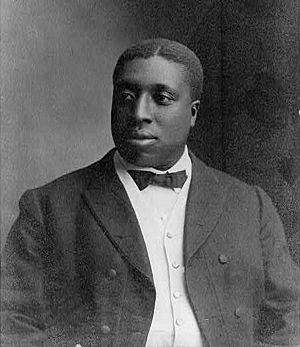William Tecumseh Vernon facts for kids
Quick facts for kids
William T. Vernon
|
|
|---|---|

William Tecumseh Vernon
|
|
| Born | 11 July 1871 Lebanon, Missouri, U.S.
|
| Died | 25 July 1944 (aged 73) Kansas City, Kansas, U.S.
|
| Occupation | Minister |
| Spouse(s) | Emily J. Embry |
| Parent(s) | Rev. Adam Vernon |
William Tecumseh Vernon (July 11, 1871 – July 25, 1944) was an important American educator, minister, and bishop. He was a leader in the African Methodist Episcopal Church. He served as president of Western University starting in 1896. He also worked for the U.S. government as Register of the Treasury from 1906 to 1911.
Early Life
William Tecumseh Vernon was born in Lebanon, Missouri. His parents had been enslaved but were now free. They likely named him after a famous Civil War general, William Tecumseh Sherman. William went to school in Lebanon.
A Leader in Education
After finishing school, Vernon taught for several years. In 1896, when he was 25, he became a minister in the African Methodist Episcopal Church.
That same year, he became president of Western University. This was a historically Black university near Kansas City. It was supported by the A.M.E. Church. Vernon brought new energy to the school. He helped the school get government support to add industrial education. This meant training for jobs in farming and mechanical trades. He built new buildings, including dorms, to support these programs.
Vernon strongly believed in the power of education. He once said that education could bring new life to people who had been held back by slavery. He believed it would help his people achieve greatness and surprise the world.
Working for the Government
William Vernon became well-known as a Republican leader. In 1906, President Theodore Roosevelt chose him to be the Register of the Treasury. This meant his signature appeared on all U.S. money printed during his time.
He was briefly reappointed by President William Howard Taft in 1910. Later, Vernon accepted a new federal job. He became the Supervisor of Indian and Negro Schools in Oklahoma. This area had recently become a state.
Later Years and Legacy
In 1912, the A.M.E. Church appointed Vernon as president of Campbell College. This school was in Jackson, Mississippi. He led the college until 1915. After that, Vernon returned to being a pastor. He served at Avery Chapel in Memphis, Tennessee, from 1916 to 1920.
In 1920, Vernon became a bishop. He then traveled to South Africa as a missionary. He worked in the Transvaal district for four years. The AME Church had many followers among the local people in South Africa. The church also helped students from South Africa come to the United States for college.
During the Great Depression in 1933, the A.M.E. Church stopped supporting Western University. The state government then provided money for the school. The governor asked Vernon to lead the industrial department. He hired excellent teachers and helped the school get its accreditation back. He stepped down in 1936.
Books
Vernon wrote two books about race and politics:
- The Upbuilding of a Race: or The Rise of a Great People (1904) – This book was a collection of his speeches and writings on education and public affairs.
- What the American Negro expects of World-wide Democracy: A statement of the Negro's Case and Cause (1919)


